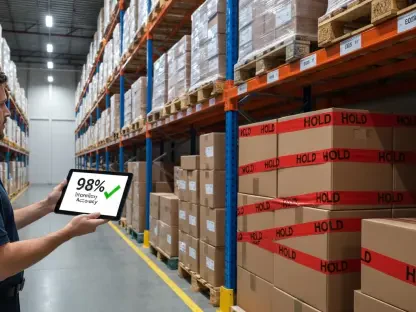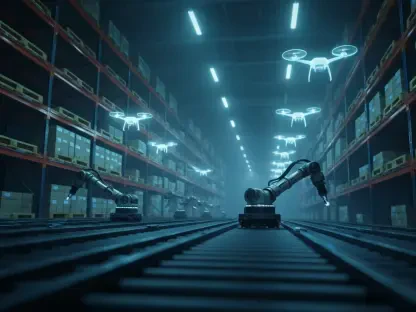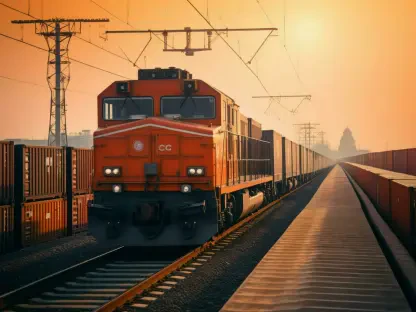In the high-stakes world of petrochemicals, where margins are razor-thin and global competition is relentless, a staggering statistic emerges: inefficiencies in loading processes alone can cost plants millions annually due to delays and labor expenses. Picture a sprawling facility struggling with aging infrastructure, where a single pallet of polyethylene takes 45 minutes to load manually, stalling production and inflating costs. This scenario is all too common in an industry at a breaking point, grappling with overcapacity and sustainability mandates. The question looms large—how can companies turn the tide without building new facilities? Automation offers a compelling answer, promising to revolutionize asset efficiency and safeguard profitability.
The significance of this challenge cannot be overstated. With economic slowdowns and geopolitical turbulence shaking the market, petrochemical producers face an urgent need to maximize value from existing assets. The push toward decarbonization adds another layer of complexity, demanding innovative solutions that balance immediate operational gains with long-term environmental goals. This exploration delves into how automation can address these pressing issues, transforming bottlenecks into opportunities and ensuring competitiveness in a volatile landscape.
Why Are Petrochemical Companies Under Pressure?
The petrochemical sector stands on shaky ground as market volatility driven by trade policies and global overcapacity threatens profitability. Plants across Europe are reevaluating their portfolios, with some facing potential closures due to their inability to keep up with demand fluctuations. The economic downturn compounds these struggles, leaving little room for capital-intensive expansions and forcing a hard look at operational inefficiencies that erode margins.
Beyond financial strain, the industry confronts an existential shift toward sustainability. Regulatory pressures to reduce carbon footprints are intensifying, compelling companies to rethink traditional practices while maintaining output. This dual challenge of staying profitable and aligning with green mandates creates a perfect storm, where innovation becomes not just an option but a necessity for survival.
Unveiling the Hidden Costs of Outdated Operations
Legacy systems in petrochemical plants reveal a harsh reality of inefficiency that directly impacts the bottom line. Aging infrastructure often lacks the capacity for additional loading docks, creating bottlenecks that slow down the handling of materials like polypropylene. Manual loading, reliant on forklifts, not only delays processes but also racks up significant labor costs, draining resources that could be allocated elsewhere.
Safety concerns further compound these operational woes. Workers face constant risks from chemical exposure and confined spaces while handling hazardous granules, with accidents potentially leading to costly downtime or worse. These persistent issues highlight a critical need for modernization, as outdated methods clash with the industry’s broader goals of cost reduction and risk mitigation.
Automation: A Catalyst for Operational Transformation
Automation emerges as a powerful solution to the inefficiencies plaguing petrochemical facilities. Automated loading systems can slash pallet loading times from 45 minutes to just a few minutes, eliminating reliance on forklifts and boosting throughput. For instance, transporting PVC granules becomes seamless with integrated buffering systems, ensuring a smooth material flow that keeps production humming.
The benefits extend beyond speed to significant safety improvements. By minimizing human interaction with hazardous substances, these systems reduce the likelihood of spills or injuries, creating a safer workplace. Additionally, the reduction in labor and maintenance expenses tied to manual processes delivers substantial cost savings, allowing plants to redirect funds toward strategic priorities.
Industry Voices on the Power of Automated Solutions
Expert perspectives underscore the strategic importance of embracing automation in this sector. Wouter Satijn, Chief Revenue Officer at a leading logistics solutions provider, emphasizes that automated loading systems offer both immediate efficiency gains and the agility needed to adapt to market shifts. His insights point to a future where technology is a cornerstone of resilience, enabling companies to navigate uncertainty with confidence.
Data backs up these claims, with studies showing that automated systems can cut operational costs by up to 30% while improving safety metrics significantly. Real-world examples further illustrate this impact—plants that have adopted such technologies report not only higher throughput but also a marked decrease in workplace incidents, proving that automation is a game-changer for both profitability and employee well-being.
Steps to Integrate Automation in Petrochemical Plants
For companies ready to take the leap, a structured approach to implementing automation is essential. The first step involves a thorough assessment of current loading bottlenecks and safety hazards, identifying specific pain points in handling materials like polyethylene. This analysis lays the groundwork for selecting scalable systems tailored to the unique needs of each facility, ensuring a targeted impact.
Next, integrating real-time data analytics into these systems can enhance decision-making, providing insights into material flow and operational performance. Training programs for staff are equally critical to ensure a smooth transition, minimizing resistance and maximizing adoption. Aligning these efforts with sustainability objectives further strengthens the case for automation, as reduced energy use and waste contribute to environmental goals while optimizing asset efficiency.
Reflecting on a Path Forward
Looking back, the journey through the petrochemical industry’s challenges revealed a landscape fraught with economic and operational hurdles, yet ripe with potential for transformation. The inefficiencies of manual processes stood out as a glaring barrier, but the promise of automation shone as a beacon of hope. Each step, from identifying hidden costs to embracing expert-backed solutions, painted a picture of an industry poised for renewal.
The next chapter for petrochemical companies hinges on actionable progress. Prioritizing the adoption of automated loading systems emerged as a clear strategy to enhance throughput and safety. Beyond immediate fixes, fostering a culture of innovation and adaptability proved vital, ensuring that existing assets delivered maximum value. As the sector reflected on these insights, the focus shifted to building partnerships with technology providers and investing in training, setting the stage for a more efficient and sustainable era.









